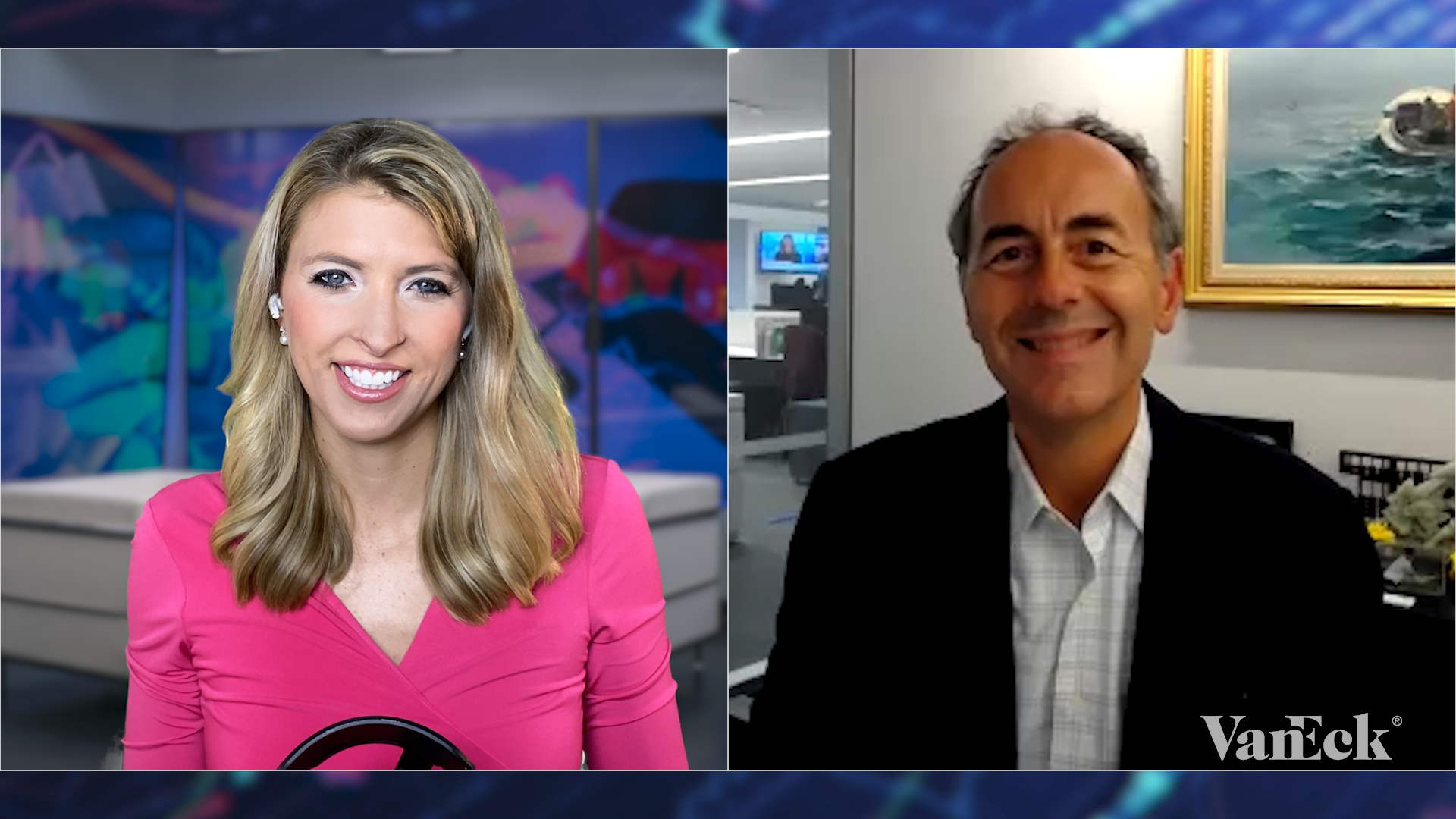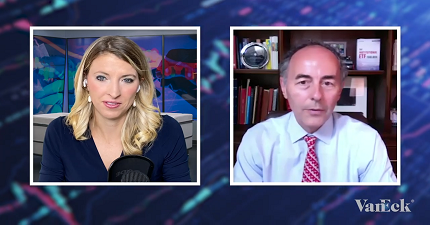Approaching the Fed “Balloon”, Energy Transition and Crypto Disruption
09 September 2021
Watch Time 8:54
Jenna Dagenhart: Joining us now with his quarterly outlook on inflation, markets, monetary policy and more, we have VanEck Chief Executive Officer, Jan van Eck. Jan, great to have you back with us. Let's start with rising price levels, which seem to be driven by supply chain issues now, more so than demand. Do you think inflation will be transitory as the Fed (Federal Reserve) has indicated? And what are your thoughts on wage pressure, given this labor market that really just keeps surprising us?
Jan van Eck: Jenna, great to see you. Let's just replay it back to the beginning of the year a little bit, when we saw the economy as a car going 200 miles an hour with China and the U.S. hurtling forward, the U.S. with a lot of stimulus. The risk was, could the car slow down to 70 miles an hour and not put too much pressure on interest rates or anything that would upset the financial markets? We call that, what are the risks to Goldilocks? Inflation is the big question. I think we don't know now, so it's a little bit unsatisfying. But if you want to call it the halftime score, right now, it's looking a little worrisome.
Jan van Eck: The big question is always what the Fed does. And let me unpack that. What we worry about more with respect to inflation is wage inflation, not lumber prices or natural gas prices, although, of course, they matter at some level. But wage inflation tends to be stickier. In the long run that can really affect long-term interest rates, 10-year interest rates. If interest rates go up, of course, that's bad for both stocks and bonds. I would say the inflation side of the argument is winning so far, because as you said, whether it's supply chain issues or labor market issues, we're still talking about these things, I think, way longer than the transitory camp would like. I don't think we'll know until next summer, for sure, but it is something to keep an eye on. The biggest risk to Goldilocks, as we talked about three months ago, is higher interest rates by the end of the summer.
Jan van Eck: Now, the problem is, it's really hard for us to figure this all out, because the Fed has inflated this balloon and is the biggest effect, both on the stock and the bond markets. Just for example, the Fed buying a bond, it bought more TIPS (Treasury Inflation-Protected Securities) last year than actually were issued. So, what really are the 10-year rates? We don't know until the Fed starts tapering. That's the big risk to the portfolios, both stock and bond portfolios. I like to say, I wish I could give you a one-month or three-month outlook, but I really don't know whether we'll know what the answer is until about a year from now.
Jenna Dagenhart: That makes sense. And what about greenflation?
Jan van Eck: Well, that's another one of these surprises that's affected commodity prices. The globe is growing. Our world economy is growing. As demand for commodity grows, it's actually hard because of ESG policies to increase supply, which means that there is this multi-year trend of price pressure. One of my colleagues cleverly called it, as you said, greenflation. It's hard to find a new copper mine, or lithium mine, or gold mine, or other places to do this activity because, to a certain extent, it's environmentally unfriendly. That will be an underpinning of commodity prices and is why, I think, that commodity-related equities are an interesting investment and people should have them in their portfolios.
Jenna Dagenhart: You're not the only one keeping a close eye on inflation. Of course, this is key for the Fed as well, as it weighs when to start tapering. How are you monitoring monetary policy and rates?
Jan van Eck: It's really hard to do. I think, again, it's like the Fed has inflated this balloon. Bank of America came out with a great study, that we were talking about, which is that a lot of the S&P [500]'s performance has come from the Fed's balance sheet expansion. That's really amazing over the last 10 years.
Jenna Dagenhart: Rather than earnings, which would typically be the case.
Jan van Eck: Right. Right. Yes. Then the risk is, of course, some bad shock happens, like in March and April of last year, but then just the Fed pushes more air into the balloon. That's why markets are so incredibly overvalued these days on the price-to-sales and price-to-earnings basis. It's really a bet on the Fed. I personally think it's not bad to keep some money on the sidelines and wait until prices get a little bit cheaper.
Jenna Dagenhart: On that note, it seems like unicorns aren't that rare anymore. You're seeing an awakening of zombie stocks as well. Should investors be afraid that valuations have gone too far?
Jan van Eck: The 0% interest rates that the Fed has happened has meant that there is overvaluation in the private markets as well as the public markets. It's great that IPOs are happening again. But the fact is they're coming to market at very rich price-to-sales. Private companies are going for 20 times price-to-sales. They're growing super-fast. But that's like a market valuation. When they finally go public, my example is Uber, they go public, they're great businesses, but the stocks are like zombie stocks. They're disconnected from the profitability and revenue growth of the underlying company. I think investors have to be aware of being able to last several years, where the business catches up with the zombie stock.
Jenna Dagenhart: Finally, with historically low yields and these record-high valuations, many people are really just looking for places to park their money. It seems like more investors are dipping into alternatives. Where are you finding opportunities right now?
Jan van Eck: Well, everyone is looking for yield. Two of the themes that we're focusing on, I think, are multi-year trends. One is the energy transition, which is basically moving away from fossil fuels. This is being driven by a lot of innovation in the private sector. It's not just the Green New Deal and government policies, which I think people tend to lose track of. In our resources portfolios, besides finding a ton of value in some of those commodity equity names that I mentioned before, we're also looking for innovation, disruptive companies in the multiple sectors that need to be more energy efficient. One that we like to focus on is agriculture, which emits about as much CO2 as, actually, the energy sector. So that's one trend.
Jan van Eck: Then another high-conviction theme, investment theme, that we have is blockchain, crypto, or whatever you want to call it, and just the fact that this open-source database technology can really provide a lot of financial solutions at much cheaper prices, sometimes 90% cheaper, in transmission. That fintech revolution that goes hand in hand with crypto, we think is really exciting. Again, there are some overvalued companies, but we think it's a really, really interesting multi-year trend that investors should be involved with.
Jenna Dagenhart: Well, it should be an interesting quarter, Jan. Thank you for joining us.
Jan van Eck: Great to see you again.
Jenna Dagenhart: Thank you for watching. That was CEO Jan van Eck. And I'm Jenna Dagenhart with Asset TV. To receive regular updates from VanEck experts, please visit vaneck.com/ucits/subscribe.








